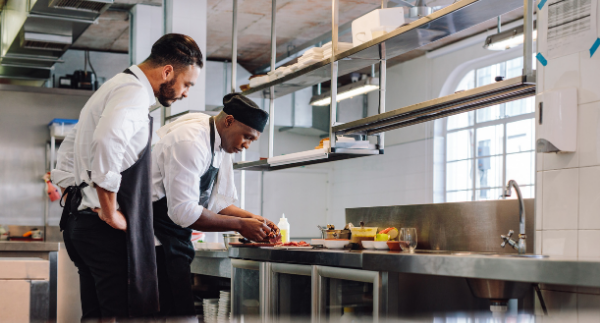Restaurant owners take on a lot of risks to follow their dreams. They can be held responsible for any accidents or damages that occur while serving customers.
Working in a restaurant also comes with potential hazards - think of all the open flames, sharp knives, and slippery surfaces yourself, your employees, and your clients could encounter daily.
In this blog post, guest contributor Sean X Cummings looks at the four common business risks you might encounter when owning a restaurant and explores different steps you can take to keep your business safe.

There is also a considerable risk of business disruption due to property damage. Restaurants rely on a lot of equipment to prepare food and serve their customers - equipment which has a lot of daily wear-and-tear such as knives, could easily be damaged. Additionally, any venue where customers ingest food could also present a potential risk for customers, like food poisoning.
1. Employee injuries
It's common knowledge that working in the hospitality industry comes with risks of accidents for employees.
For example:
- A cook could cut themselves while chopping onions.
- An employee could slip and fall because of a slippery floor.
- Kitchen workers could suffer a back injury while unloading supplies.
Given the amount of exposure restaurant workers have, workplace safety training is crucial to keep your employees safe at work. To avoid workplace accidents, all employees should learn how to clean, handle, and store sharp kitchen utensils. All employees should also understand how to properly lift heavy items to avoid back injuries. Additionally, staff members should also be required to wear non-slip footwear to reduce the chance of slip-and-fall injuries. Ensuring that all new employees are correctly on-boarded and conducting regular refresher training will go a long way in reducing their risk of workplace injuries.
.png?width=753&name=Typsy%20%20We%20teach%20hospitality%20to%20the%20world%20%20typsy.com%20blog%20banner%20_%20(1).png)
Learning with Typsy helps you and your team develop the kind of high-level skills you need to solve problems and deliver incredible guest experiences.
Typsy lessons are practical, effective, and fun! And best of all, you can access 1000+ topics as and when it suits you.
Learn your way - starting today.
2. Food and alcohol liability
It is very challenging for any restaurant to accommodate all of its customers' dietary restrictions, varied tastes, and allergies. However, there are some steps you could implement to keep your customers safe and avoid any accusations that could put your reputation on the line. For instance, listing any allergens such as dairy, nuts, wheat, soy, or shellfish, and warnings on your menu is a crucial step in this process.
Enforcing food safety in your kitchen is crucial as it could lead to potential lawsuits, food poisoning outbreaks, and affect your entire business. It’s fundamental to ensure your menu items are thoroughly being prepared to avoid cross-contamination if you do offer allergen-free foods.
If your venue is licensed and serves alcohol, you might be exposed to a variety of liability claims. As you may know, handling intoxicated guests or serving alcoholic beverages to underaged customers can lead to serious sanctions for your staff and your business. What’s important to note is that your restaurant could be held liable if intoxicated patrons cause damages to third parties. While clear policies for handling guests that are under the influence are an important step in mitigating this liability - it’s also important to consider liquor liability insurance.
3. Injuries to customers
For most businesses, there is a risk that a customer could enter the premises, and trip and fall. Given how much foot-traffic most restaurants get, there is a higher chance that your customers (and staff members!) might get injured in your venue from a spilled drink in the office or a chair in the middle of your restaurant. Additionally, restaurants deal with spillage and regular clean-up efforts and need to be extra careful when it comes to creating slippery surfaces. This is why it is essential to respond and act quickly when an incident happens.
4. Property damage
To be successful, restaurants heavily rely on their equipment and the location where their food is being sourced, prepared, and purchased. Hospitality businesses are at a significantly higher risk of property damage than many other industries. For instance, most restaurants deal with open flames and hot surfaces every day, and the risk of a fire is a distinct possibility. Restaurants suffer about 8,000 reported fires in the US each year.
Given how common the risk of fire is in the food industry, one of the key steps in protecting your equipment and your staff members is being proactive about preventing fire. Having a sufficient number of fire extinguishers and their maintenance (ensuring they are still loaded) is crucial in preventing a small fire from escalating into a complete disaster. While it represents a significant investment, larger restaurants may find it wise to invest in an automatic fire extinguishing protection system, including hood and filter systems. Additionally, gas and fuel stoves and fryers should have easy and accessible shut offs that your staff is trained in using.
While we have discussed the risks and the potential preventive methods restaurateurs can implement, training your teams remains an essential part of your staff members' and customers' safety. Every food business should also strongly consider investing in business insurance to help pay for these incidents, in addition to the preventive measures. In all of the examples, having the right insurance in place could mean the difference between moving forward with minimal distractions or going under because of the financial setbacks that these types of issues could entail.
 |
Marketing mastermind and agent of change, Sean X Cummings has been looking into the future where brands, technology, and media intersect—and manipulating the present to get there—for more than two decades. Sean is currently CMO at Embroker, a digital insurance company reinventing how businesses ensure they can take the risks they need to grow. |
You might also like: